Assignment on Health Management
VerifiedAdded on 2020/03/16
|13
|3840
|230
AI Summary
Contribute Materials
Your contribution can guide someone’s learning journey. Share your
documents today.
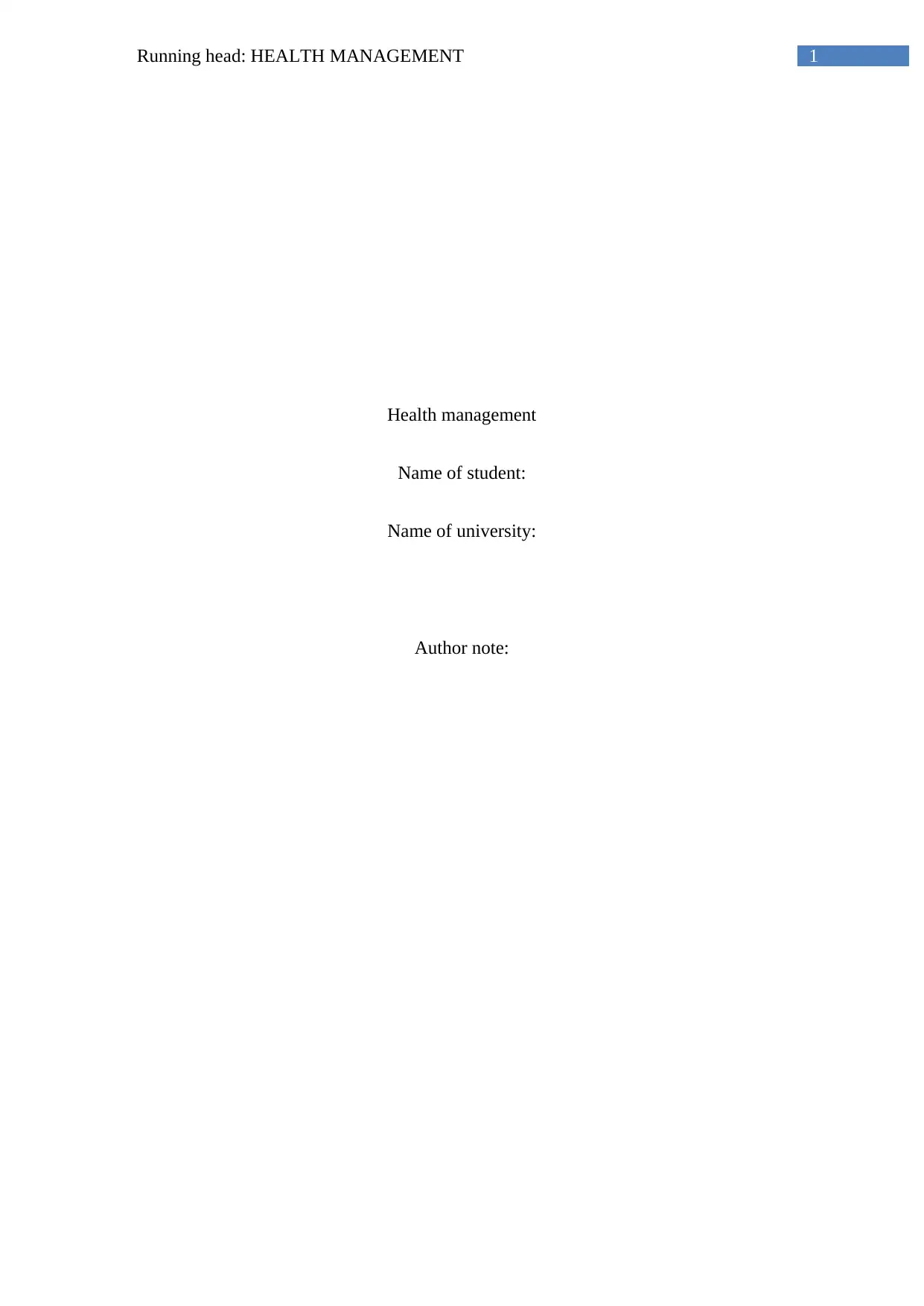
1Running head: HEALTH MANAGEMENT
Health management
Name of student:
Name of university:
Author note:
Health management
Name of student:
Name of university:
Author note:
Secure Best Marks with AI Grader
Need help grading? Try our AI Grader for instant feedback on your assignments.
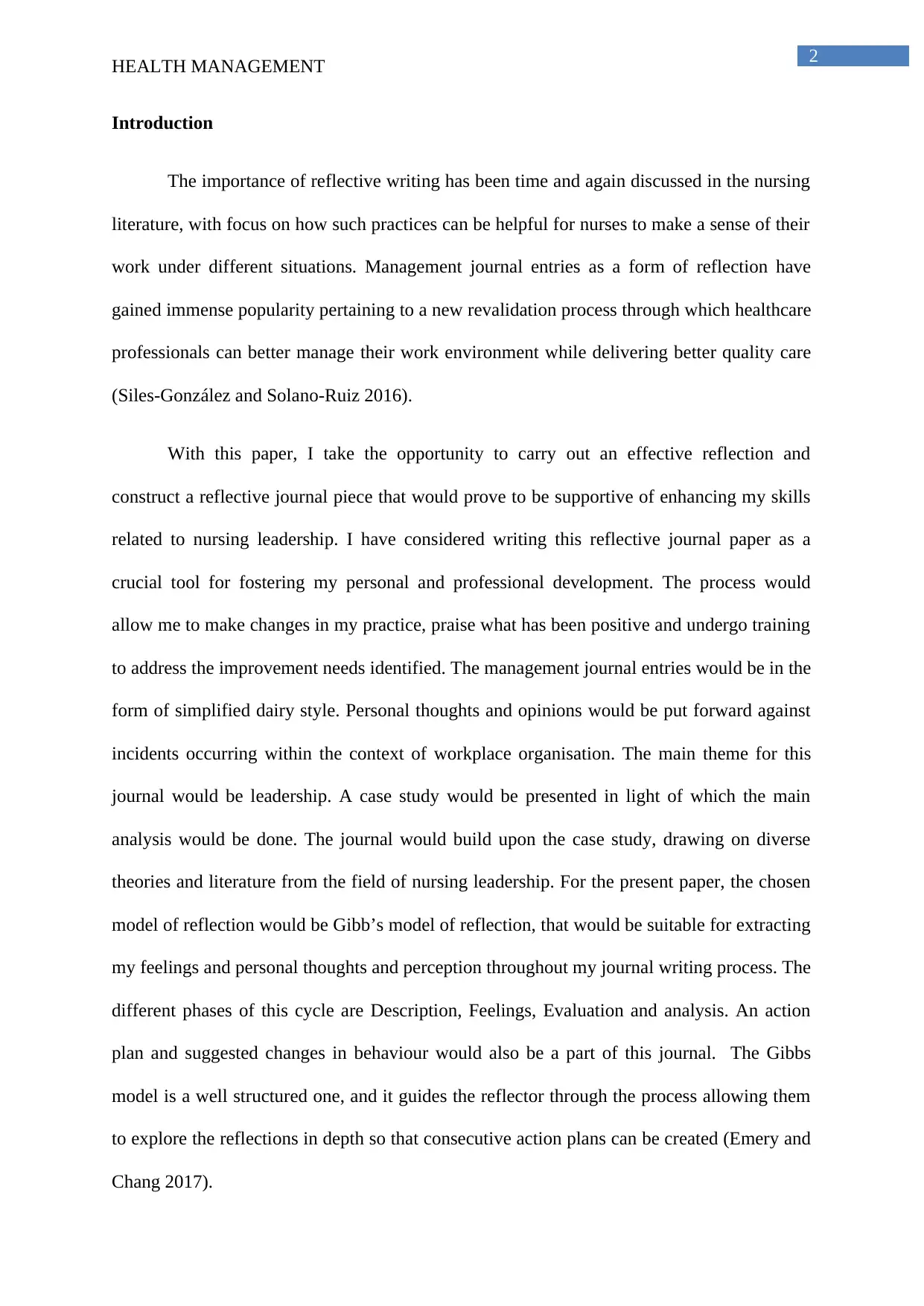
2
HEALTH MANAGEMENT
Introduction
The importance of reflective writing has been time and again discussed in the nursing
literature, with focus on how such practices can be helpful for nurses to make a sense of their
work under different situations. Management journal entries as a form of reflection have
gained immense popularity pertaining to a new revalidation process through which healthcare
professionals can better manage their work environment while delivering better quality care
(Siles-González and Solano-Ruiz 2016).
With this paper, I take the opportunity to carry out an effective reflection and
construct a reflective journal piece that would prove to be supportive of enhancing my skills
related to nursing leadership. I have considered writing this reflective journal paper as a
crucial tool for fostering my personal and professional development. The process would
allow me to make changes in my practice, praise what has been positive and undergo training
to address the improvement needs identified. The management journal entries would be in the
form of simplified dairy style. Personal thoughts and opinions would be put forward against
incidents occurring within the context of workplace organisation. The main theme for this
journal would be leadership. A case study would be presented in light of which the main
analysis would be done. The journal would build upon the case study, drawing on diverse
theories and literature from the field of nursing leadership. For the present paper, the chosen
model of reflection would be Gibb’s model of reflection, that would be suitable for extracting
my feelings and personal thoughts and perception throughout my journal writing process. The
different phases of this cycle are Description, Feelings, Evaluation and analysis. An action
plan and suggested changes in behaviour would also be a part of this journal. The Gibbs
model is a well structured one, and it guides the reflector through the process allowing them
to explore the reflections in depth so that consecutive action plans can be created (Emery and
Chang 2017).
HEALTH MANAGEMENT
Introduction
The importance of reflective writing has been time and again discussed in the nursing
literature, with focus on how such practices can be helpful for nurses to make a sense of their
work under different situations. Management journal entries as a form of reflection have
gained immense popularity pertaining to a new revalidation process through which healthcare
professionals can better manage their work environment while delivering better quality care
(Siles-González and Solano-Ruiz 2016).
With this paper, I take the opportunity to carry out an effective reflection and
construct a reflective journal piece that would prove to be supportive of enhancing my skills
related to nursing leadership. I have considered writing this reflective journal paper as a
crucial tool for fostering my personal and professional development. The process would
allow me to make changes in my practice, praise what has been positive and undergo training
to address the improvement needs identified. The management journal entries would be in the
form of simplified dairy style. Personal thoughts and opinions would be put forward against
incidents occurring within the context of workplace organisation. The main theme for this
journal would be leadership. A case study would be presented in light of which the main
analysis would be done. The journal would build upon the case study, drawing on diverse
theories and literature from the field of nursing leadership. For the present paper, the chosen
model of reflection would be Gibb’s model of reflection, that would be suitable for extracting
my feelings and personal thoughts and perception throughout my journal writing process. The
different phases of this cycle are Description, Feelings, Evaluation and analysis. An action
plan and suggested changes in behaviour would also be a part of this journal. The Gibbs
model is a well structured one, and it guides the reflector through the process allowing them
to explore the reflections in depth so that consecutive action plans can be created (Emery and
Chang 2017).

3
HEALTH MANAGEMENT
2 September 2017
From the very first day of stepping into the field of nursing practice, I have
understood the need of bringing continual development in competencies and skills to a better
professional life. I have considered reflecting writing as the most beneficial tool for
highlighting issues and challenges faced within the organisational context. One aspect of
nursing practice that has always drawn my attention in relation to different clinical situations
is nursing leadership. Through the consequent research that I have undertaken on nursing
leadership, I have developed the idea that nursing leadership has multiple definitions for it.
Perhaps the most suitable definition for leadership is the ability to demonstrate critical
thinking, advocacy and action. The fact that leadership plays a pivotal role in the lives of
health care professionals across domains and clinical settings is acknowledged by me. I
believe that leadership has a profound impact on the entire healthcare system, including both
the care givers and the patients. As a nurse leader, I would be responsible for designing and
implementing client care as per the individual needs of the healthcare consumers.
Carrying out an in-depth research on different forms of leadership, I have
come acrosss terms such as quantum leadership, servant leadership, transformational
leadership and transactional leadership. For me, the leadership journey is not an even one.
Coming out of my shell and overcoming my nervousness and introversion has never been
easy. According to Fitzpatrick (2017) leadership is all about getting oneself heard. For this,
an individual must overcome his coyness and put forward own thoughts and opinions in a
clear and distinct manner. Being mentored and guided by a senior professional in the field
was the path changing event for me. It was only when I was helped out by my senior that I
started my journey towards embracing the opportunities leadership brings with it.
HEALTH MANAGEMENT
2 September 2017
From the very first day of stepping into the field of nursing practice, I have
understood the need of bringing continual development in competencies and skills to a better
professional life. I have considered reflecting writing as the most beneficial tool for
highlighting issues and challenges faced within the organisational context. One aspect of
nursing practice that has always drawn my attention in relation to different clinical situations
is nursing leadership. Through the consequent research that I have undertaken on nursing
leadership, I have developed the idea that nursing leadership has multiple definitions for it.
Perhaps the most suitable definition for leadership is the ability to demonstrate critical
thinking, advocacy and action. The fact that leadership plays a pivotal role in the lives of
health care professionals across domains and clinical settings is acknowledged by me. I
believe that leadership has a profound impact on the entire healthcare system, including both
the care givers and the patients. As a nurse leader, I would be responsible for designing and
implementing client care as per the individual needs of the healthcare consumers.
Carrying out an in-depth research on different forms of leadership, I have
come acrosss terms such as quantum leadership, servant leadership, transformational
leadership and transactional leadership. For me, the leadership journey is not an even one.
Coming out of my shell and overcoming my nervousness and introversion has never been
easy. According to Fitzpatrick (2017) leadership is all about getting oneself heard. For this,
an individual must overcome his coyness and put forward own thoughts and opinions in a
clear and distinct manner. Being mentored and guided by a senior professional in the field
was the path changing event for me. It was only when I was helped out by my senior that I
started my journey towards embracing the opportunities leadership brings with it.
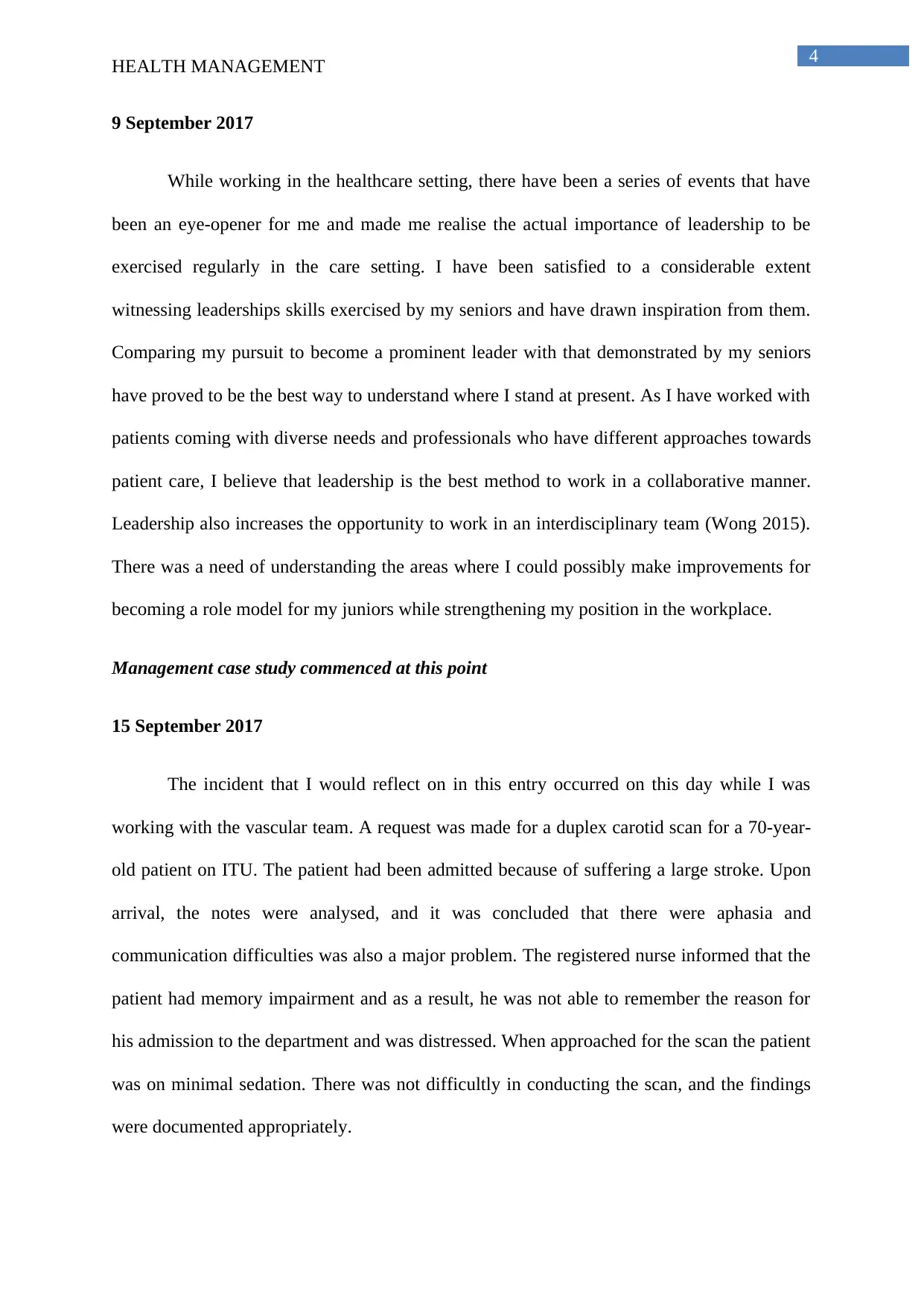
4
HEALTH MANAGEMENT
9 September 2017
While working in the healthcare setting, there have been a series of events that have
been an eye-opener for me and made me realise the actual importance of leadership to be
exercised regularly in the care setting. I have been satisfied to a considerable extent
witnessing leaderships skills exercised by my seniors and have drawn inspiration from them.
Comparing my pursuit to become a prominent leader with that demonstrated by my seniors
have proved to be the best way to understand where I stand at present. As I have worked with
patients coming with diverse needs and professionals who have different approaches towards
patient care, I believe that leadership is the best method to work in a collaborative manner.
Leadership also increases the opportunity to work in an interdisciplinary team (Wong 2015).
There was a need of understanding the areas where I could possibly make improvements for
becoming a role model for my juniors while strengthening my position in the workplace.
Management case study commenced at this point
15 September 2017
The incident that I would reflect on in this entry occurred on this day while I was
working with the vascular team. A request was made for a duplex carotid scan for a 70-year-
old patient on ITU. The patient had been admitted because of suffering a large stroke. Upon
arrival, the notes were analysed, and it was concluded that there were aphasia and
communication difficulties was also a major problem. The registered nurse informed that the
patient had memory impairment and as a result, he was not able to remember the reason for
his admission to the department and was distressed. When approached for the scan the patient
was on minimal sedation. There was not difficultly in conducting the scan, and the findings
were documented appropriately.
HEALTH MANAGEMENT
9 September 2017
While working in the healthcare setting, there have been a series of events that have
been an eye-opener for me and made me realise the actual importance of leadership to be
exercised regularly in the care setting. I have been satisfied to a considerable extent
witnessing leaderships skills exercised by my seniors and have drawn inspiration from them.
Comparing my pursuit to become a prominent leader with that demonstrated by my seniors
have proved to be the best way to understand where I stand at present. As I have worked with
patients coming with diverse needs and professionals who have different approaches towards
patient care, I believe that leadership is the best method to work in a collaborative manner.
Leadership also increases the opportunity to work in an interdisciplinary team (Wong 2015).
There was a need of understanding the areas where I could possibly make improvements for
becoming a role model for my juniors while strengthening my position in the workplace.
Management case study commenced at this point
15 September 2017
The incident that I would reflect on in this entry occurred on this day while I was
working with the vascular team. A request was made for a duplex carotid scan for a 70-year-
old patient on ITU. The patient had been admitted because of suffering a large stroke. Upon
arrival, the notes were analysed, and it was concluded that there were aphasia and
communication difficulties was also a major problem. The registered nurse informed that the
patient had memory impairment and as a result, he was not able to remember the reason for
his admission to the department and was distressed. When approached for the scan the patient
was on minimal sedation. There was not difficultly in conducting the scan, and the findings
were documented appropriately.
Secure Best Marks with AI Grader
Need help grading? Try our AI Grader for instant feedback on your assignments.
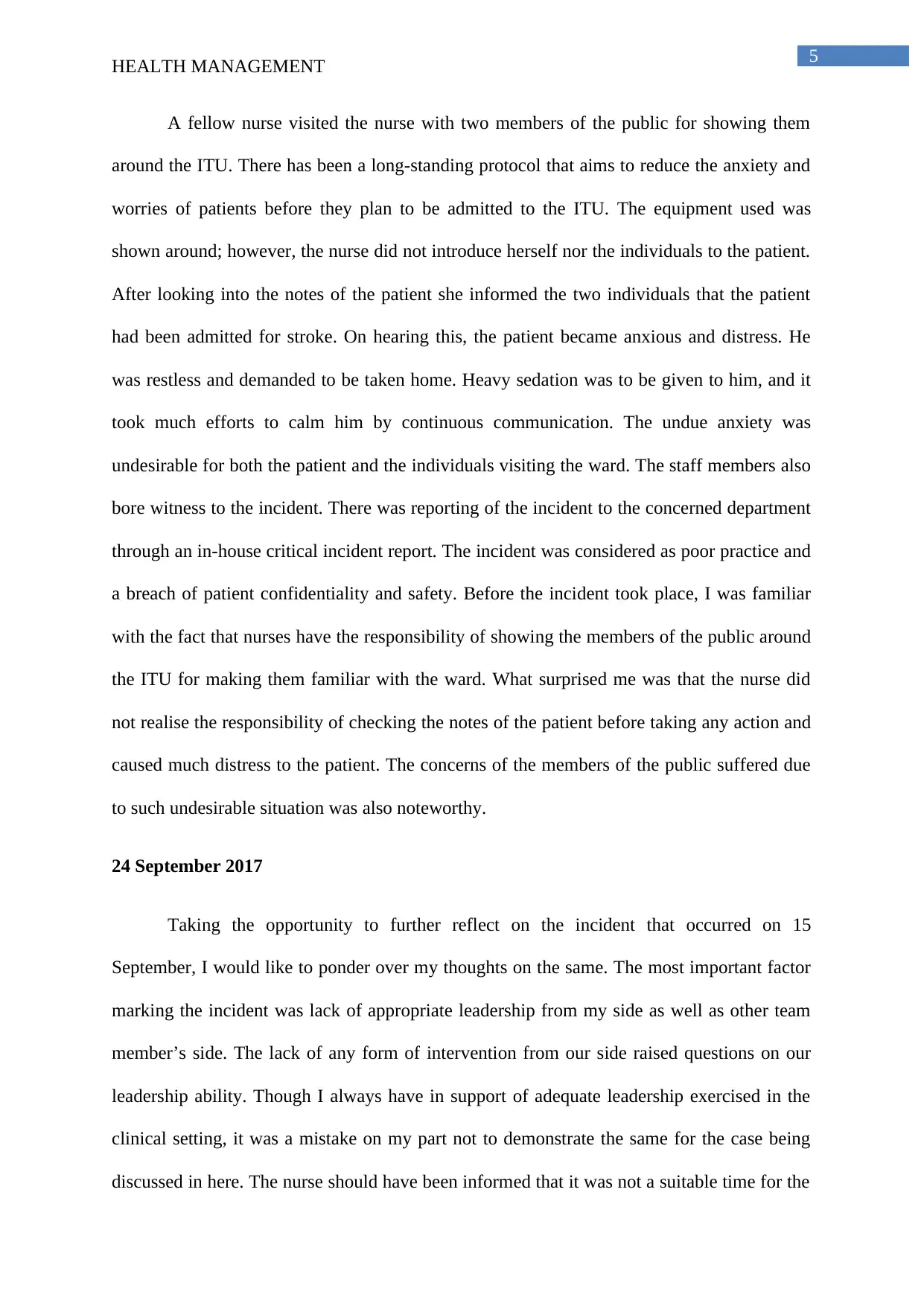
5
HEALTH MANAGEMENT
A fellow nurse visited the nurse with two members of the public for showing them
around the ITU. There has been a long-standing protocol that aims to reduce the anxiety and
worries of patients before they plan to be admitted to the ITU. The equipment used was
shown around; however, the nurse did not introduce herself nor the individuals to the patient.
After looking into the notes of the patient she informed the two individuals that the patient
had been admitted for stroke. On hearing this, the patient became anxious and distress. He
was restless and demanded to be taken home. Heavy sedation was to be given to him, and it
took much efforts to calm him by continuous communication. The undue anxiety was
undesirable for both the patient and the individuals visiting the ward. The staff members also
bore witness to the incident. There was reporting of the incident to the concerned department
through an in-house critical incident report. The incident was considered as poor practice and
a breach of patient confidentiality and safety. Before the incident took place, I was familiar
with the fact that nurses have the responsibility of showing the members of the public around
the ITU for making them familiar with the ward. What surprised me was that the nurse did
not realise the responsibility of checking the notes of the patient before taking any action and
caused much distress to the patient. The concerns of the members of the public suffered due
to such undesirable situation was also noteworthy.
24 September 2017
Taking the opportunity to further reflect on the incident that occurred on 15
September, I would like to ponder over my thoughts on the same. The most important factor
marking the incident was lack of appropriate leadership from my side as well as other team
member’s side. The lack of any form of intervention from our side raised questions on our
leadership ability. Though I always have in support of adequate leadership exercised in the
clinical setting, it was a mistake on my part not to demonstrate the same for the case being
discussed in here. The nurse should have been informed that it was not a suitable time for the
HEALTH MANAGEMENT
A fellow nurse visited the nurse with two members of the public for showing them
around the ITU. There has been a long-standing protocol that aims to reduce the anxiety and
worries of patients before they plan to be admitted to the ITU. The equipment used was
shown around; however, the nurse did not introduce herself nor the individuals to the patient.
After looking into the notes of the patient she informed the two individuals that the patient
had been admitted for stroke. On hearing this, the patient became anxious and distress. He
was restless and demanded to be taken home. Heavy sedation was to be given to him, and it
took much efforts to calm him by continuous communication. The undue anxiety was
undesirable for both the patient and the individuals visiting the ward. The staff members also
bore witness to the incident. There was reporting of the incident to the concerned department
through an in-house critical incident report. The incident was considered as poor practice and
a breach of patient confidentiality and safety. Before the incident took place, I was familiar
with the fact that nurses have the responsibility of showing the members of the public around
the ITU for making them familiar with the ward. What surprised me was that the nurse did
not realise the responsibility of checking the notes of the patient before taking any action and
caused much distress to the patient. The concerns of the members of the public suffered due
to such undesirable situation was also noteworthy.
24 September 2017
Taking the opportunity to further reflect on the incident that occurred on 15
September, I would like to ponder over my thoughts on the same. The most important factor
marking the incident was lack of appropriate leadership from my side as well as other team
member’s side. The lack of any form of intervention from our side raised questions on our
leadership ability. Though I always have in support of adequate leadership exercised in the
clinical setting, it was a mistake on my part not to demonstrate the same for the case being
discussed in here. The nurse should have been informed that it was not a suitable time for the
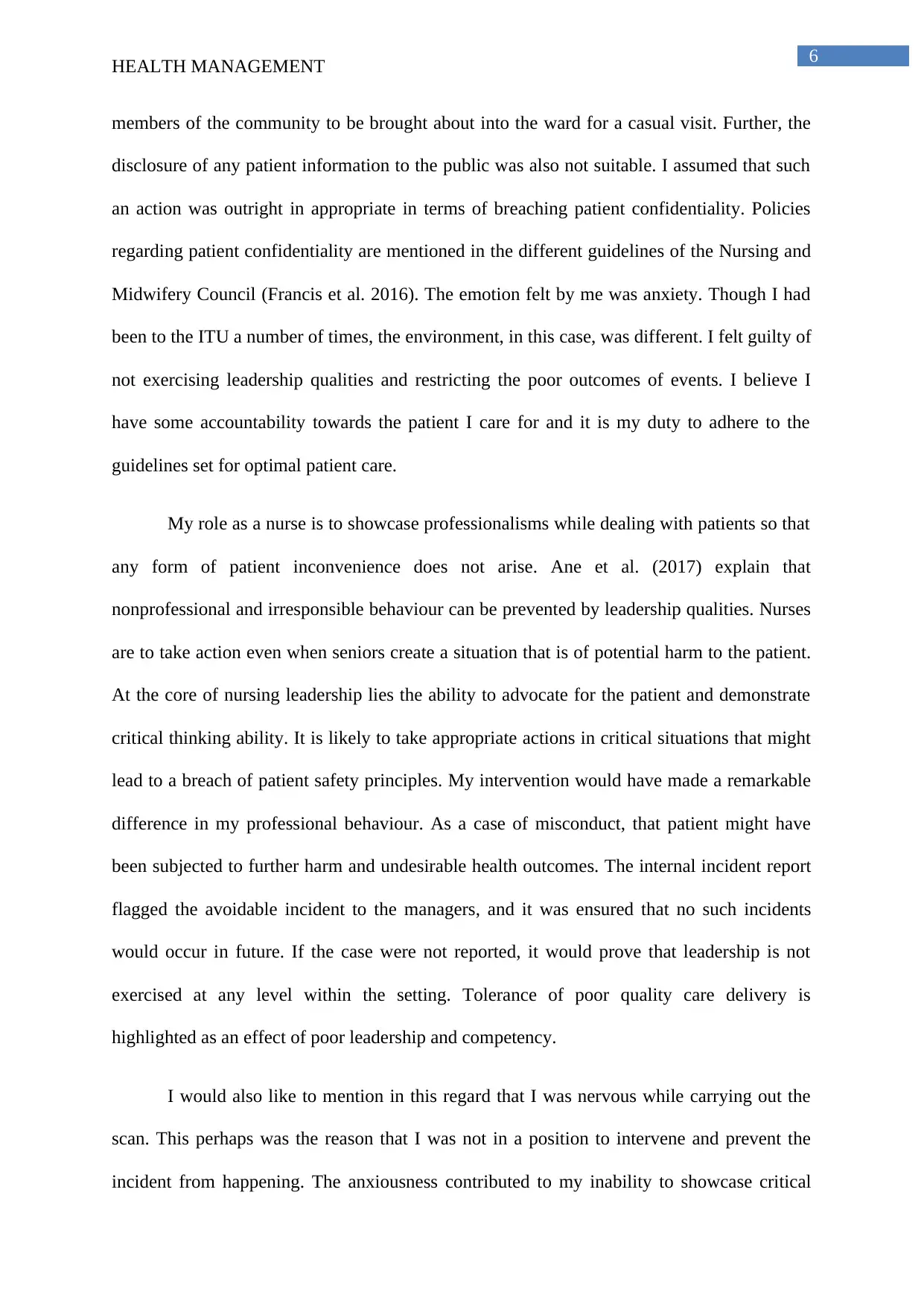
6
HEALTH MANAGEMENT
members of the community to be brought about into the ward for a casual visit. Further, the
disclosure of any patient information to the public was also not suitable. I assumed that such
an action was outright in appropriate in terms of breaching patient confidentiality. Policies
regarding patient confidentiality are mentioned in the different guidelines of the Nursing and
Midwifery Council (Francis et al. 2016). The emotion felt by me was anxiety. Though I had
been to the ITU a number of times, the environment, in this case, was different. I felt guilty of
not exercising leadership qualities and restricting the poor outcomes of events. I believe I
have some accountability towards the patient I care for and it is my duty to adhere to the
guidelines set for optimal patient care.
My role as a nurse is to showcase professionalisms while dealing with patients so that
any form of patient inconvenience does not arise. Ane et al. (2017) explain that
nonprofessional and irresponsible behaviour can be prevented by leadership qualities. Nurses
are to take action even when seniors create a situation that is of potential harm to the patient.
At the core of nursing leadership lies the ability to advocate for the patient and demonstrate
critical thinking ability. It is likely to take appropriate actions in critical situations that might
lead to a breach of patient safety principles. My intervention would have made a remarkable
difference in my professional behaviour. As a case of misconduct, that patient might have
been subjected to further harm and undesirable health outcomes. The internal incident report
flagged the avoidable incident to the managers, and it was ensured that no such incidents
would occur in future. If the case were not reported, it would prove that leadership is not
exercised at any level within the setting. Tolerance of poor quality care delivery is
highlighted as an effect of poor leadership and competency.
I would also like to mention in this regard that I was nervous while carrying out the
scan. This perhaps was the reason that I was not in a position to intervene and prevent the
incident from happening. The anxiousness contributed to my inability to showcase critical
HEALTH MANAGEMENT
members of the community to be brought about into the ward for a casual visit. Further, the
disclosure of any patient information to the public was also not suitable. I assumed that such
an action was outright in appropriate in terms of breaching patient confidentiality. Policies
regarding patient confidentiality are mentioned in the different guidelines of the Nursing and
Midwifery Council (Francis et al. 2016). The emotion felt by me was anxiety. Though I had
been to the ITU a number of times, the environment, in this case, was different. I felt guilty of
not exercising leadership qualities and restricting the poor outcomes of events. I believe I
have some accountability towards the patient I care for and it is my duty to adhere to the
guidelines set for optimal patient care.
My role as a nurse is to showcase professionalisms while dealing with patients so that
any form of patient inconvenience does not arise. Ane et al. (2017) explain that
nonprofessional and irresponsible behaviour can be prevented by leadership qualities. Nurses
are to take action even when seniors create a situation that is of potential harm to the patient.
At the core of nursing leadership lies the ability to advocate for the patient and demonstrate
critical thinking ability. It is likely to take appropriate actions in critical situations that might
lead to a breach of patient safety principles. My intervention would have made a remarkable
difference in my professional behaviour. As a case of misconduct, that patient might have
been subjected to further harm and undesirable health outcomes. The internal incident report
flagged the avoidable incident to the managers, and it was ensured that no such incidents
would occur in future. If the case were not reported, it would prove that leadership is not
exercised at any level within the setting. Tolerance of poor quality care delivery is
highlighted as an effect of poor leadership and competency.
I would also like to mention in this regard that I was nervous while carrying out the
scan. This perhaps was the reason that I was not in a position to intervene and prevent the
incident from happening. The anxiousness contributed to my inability to showcase critical
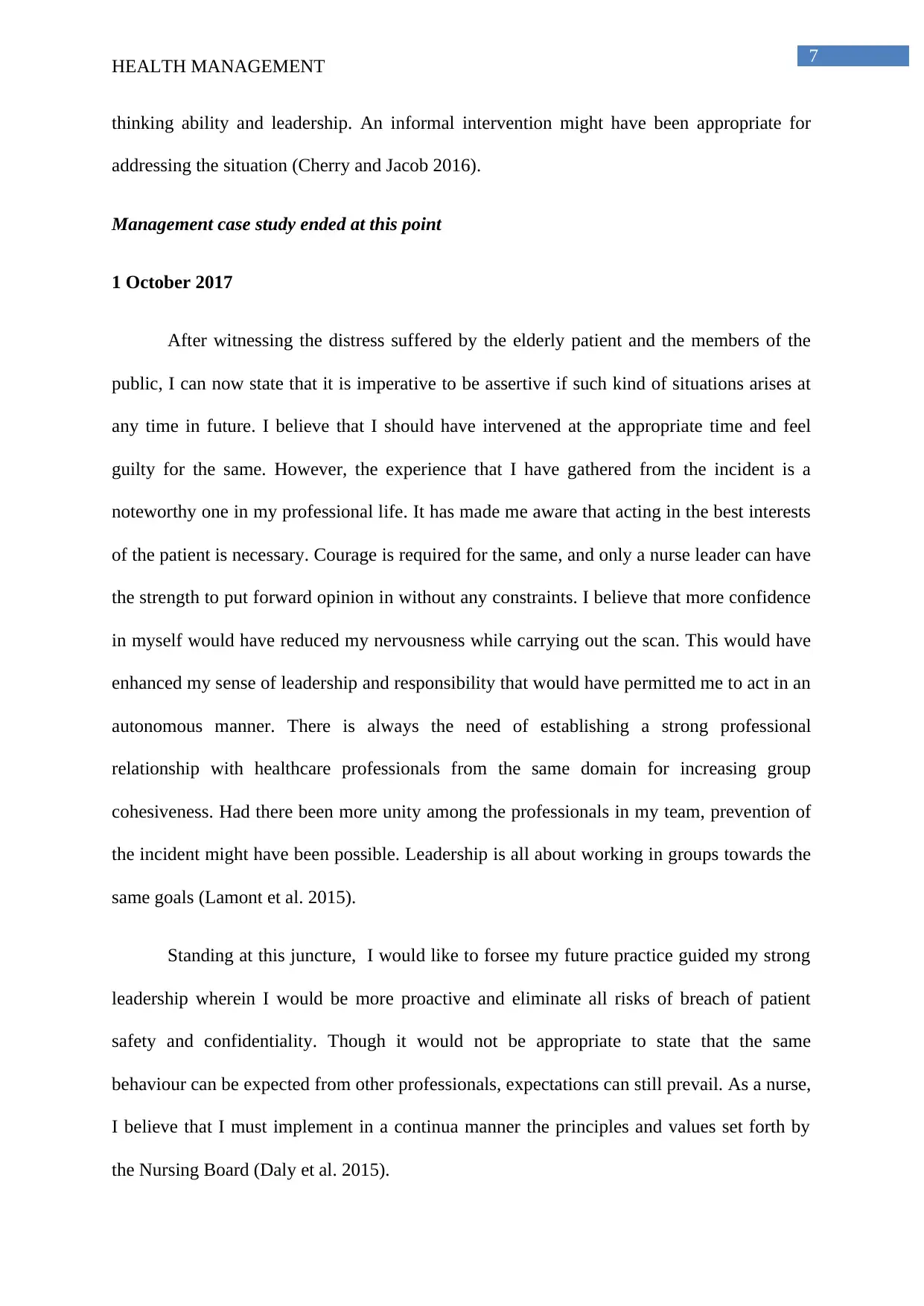
7
HEALTH MANAGEMENT
thinking ability and leadership. An informal intervention might have been appropriate for
addressing the situation (Cherry and Jacob 2016).
Management case study ended at this point
1 October 2017
After witnessing the distress suffered by the elderly patient and the members of the
public, I can now state that it is imperative to be assertive if such kind of situations arises at
any time in future. I believe that I should have intervened at the appropriate time and feel
guilty for the same. However, the experience that I have gathered from the incident is a
noteworthy one in my professional life. It has made me aware that acting in the best interests
of the patient is necessary. Courage is required for the same, and only a nurse leader can have
the strength to put forward opinion in without any constraints. I believe that more confidence
in myself would have reduced my nervousness while carrying out the scan. This would have
enhanced my sense of leadership and responsibility that would have permitted me to act in an
autonomous manner. There is always the need of establishing a strong professional
relationship with healthcare professionals from the same domain for increasing group
cohesiveness. Had there been more unity among the professionals in my team, prevention of
the incident might have been possible. Leadership is all about working in groups towards the
same goals (Lamont et al. 2015).
Standing at this juncture, I would like to forsee my future practice guided my strong
leadership wherein I would be more proactive and eliminate all risks of breach of patient
safety and confidentiality. Though it would not be appropriate to state that the same
behaviour can be expected from other professionals, expectations can still prevail. As a nurse,
I believe that I must implement in a continua manner the principles and values set forth by
the Nursing Board (Daly et al. 2015).
HEALTH MANAGEMENT
thinking ability and leadership. An informal intervention might have been appropriate for
addressing the situation (Cherry and Jacob 2016).
Management case study ended at this point
1 October 2017
After witnessing the distress suffered by the elderly patient and the members of the
public, I can now state that it is imperative to be assertive if such kind of situations arises at
any time in future. I believe that I should have intervened at the appropriate time and feel
guilty for the same. However, the experience that I have gathered from the incident is a
noteworthy one in my professional life. It has made me aware that acting in the best interests
of the patient is necessary. Courage is required for the same, and only a nurse leader can have
the strength to put forward opinion in without any constraints. I believe that more confidence
in myself would have reduced my nervousness while carrying out the scan. This would have
enhanced my sense of leadership and responsibility that would have permitted me to act in an
autonomous manner. There is always the need of establishing a strong professional
relationship with healthcare professionals from the same domain for increasing group
cohesiveness. Had there been more unity among the professionals in my team, prevention of
the incident might have been possible. Leadership is all about working in groups towards the
same goals (Lamont et al. 2015).
Standing at this juncture, I would like to forsee my future practice guided my strong
leadership wherein I would be more proactive and eliminate all risks of breach of patient
safety and confidentiality. Though it would not be appropriate to state that the same
behaviour can be expected from other professionals, expectations can still prevail. As a nurse,
I believe that I must implement in a continua manner the principles and values set forth by
the Nursing Board (Daly et al. 2015).
Paraphrase This Document
Need a fresh take? Get an instant paraphrase of this document with our AI Paraphraser
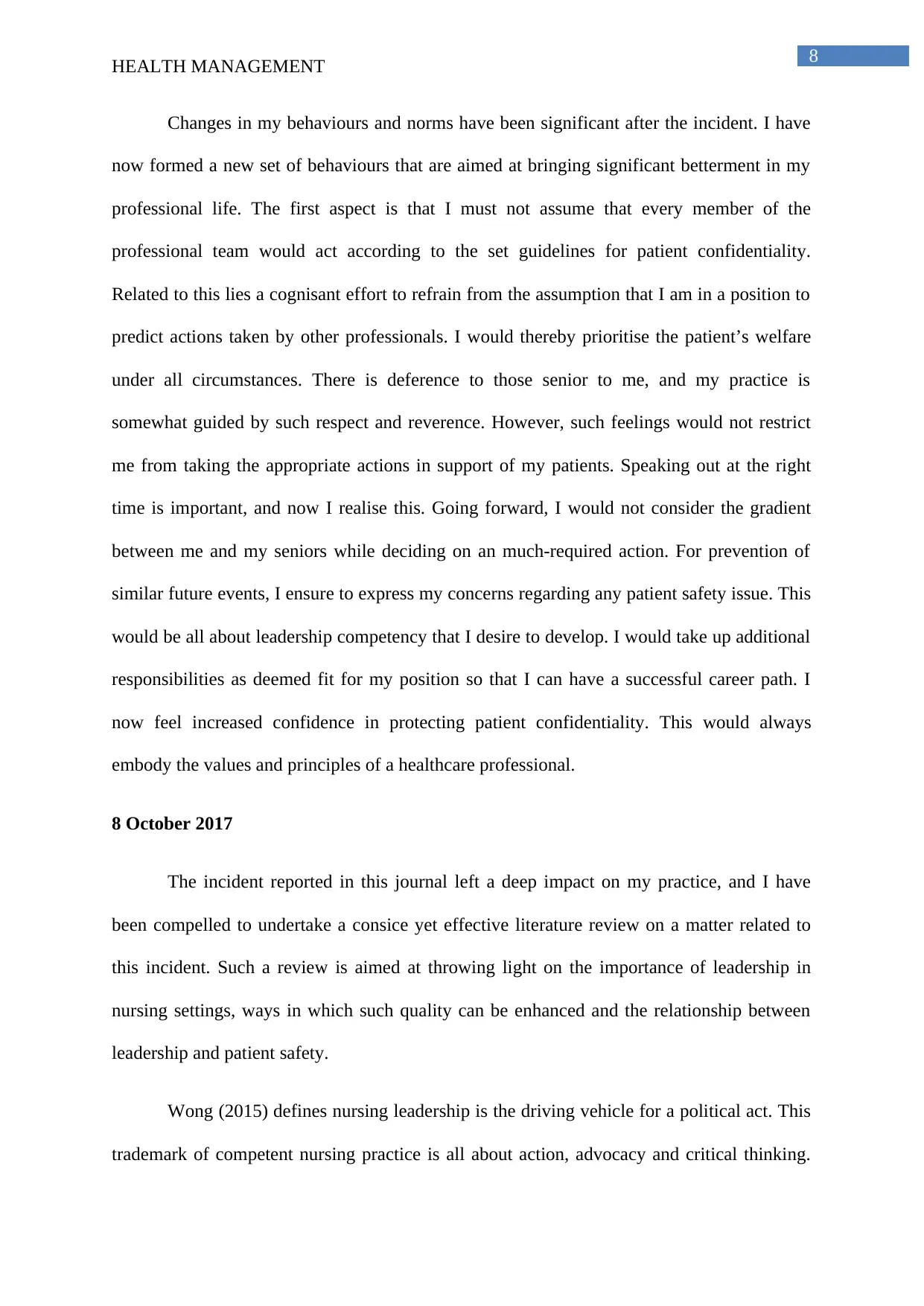
8
HEALTH MANAGEMENT
Changes in my behaviours and norms have been significant after the incident. I have
now formed a new set of behaviours that are aimed at bringing significant betterment in my
professional life. The first aspect is that I must not assume that every member of the
professional team would act according to the set guidelines for patient confidentiality.
Related to this lies a cognisant effort to refrain from the assumption that I am in a position to
predict actions taken by other professionals. I would thereby prioritise the patient’s welfare
under all circumstances. There is deference to those senior to me, and my practice is
somewhat guided by such respect and reverence. However, such feelings would not restrict
me from taking the appropriate actions in support of my patients. Speaking out at the right
time is important, and now I realise this. Going forward, I would not consider the gradient
between me and my seniors while deciding on an much-required action. For prevention of
similar future events, I ensure to express my concerns regarding any patient safety issue. This
would be all about leadership competency that I desire to develop. I would take up additional
responsibilities as deemed fit for my position so that I can have a successful career path. I
now feel increased confidence in protecting patient confidentiality. This would always
embody the values and principles of a healthcare professional.
8 October 2017
The incident reported in this journal left a deep impact on my practice, and I have
been compelled to undertake a consice yet effective literature review on a matter related to
this incident. Such a review is aimed at throwing light on the importance of leadership in
nursing settings, ways in which such quality can be enhanced and the relationship between
leadership and patient safety.
Wong (2015) defines nursing leadership is the driving vehicle for a political act. This
trademark of competent nursing practice is all about action, advocacy and critical thinking.
HEALTH MANAGEMENT
Changes in my behaviours and norms have been significant after the incident. I have
now formed a new set of behaviours that are aimed at bringing significant betterment in my
professional life. The first aspect is that I must not assume that every member of the
professional team would act according to the set guidelines for patient confidentiality.
Related to this lies a cognisant effort to refrain from the assumption that I am in a position to
predict actions taken by other professionals. I would thereby prioritise the patient’s welfare
under all circumstances. There is deference to those senior to me, and my practice is
somewhat guided by such respect and reverence. However, such feelings would not restrict
me from taking the appropriate actions in support of my patients. Speaking out at the right
time is important, and now I realise this. Going forward, I would not consider the gradient
between me and my seniors while deciding on an much-required action. For prevention of
similar future events, I ensure to express my concerns regarding any patient safety issue. This
would be all about leadership competency that I desire to develop. I would take up additional
responsibilities as deemed fit for my position so that I can have a successful career path. I
now feel increased confidence in protecting patient confidentiality. This would always
embody the values and principles of a healthcare professional.
8 October 2017
The incident reported in this journal left a deep impact on my practice, and I have
been compelled to undertake a consice yet effective literature review on a matter related to
this incident. Such a review is aimed at throwing light on the importance of leadership in
nursing settings, ways in which such quality can be enhanced and the relationship between
leadership and patient safety.
Wong (2015) defines nursing leadership is the driving vehicle for a political act. This
trademark of competent nursing practice is all about action, advocacy and critical thinking.
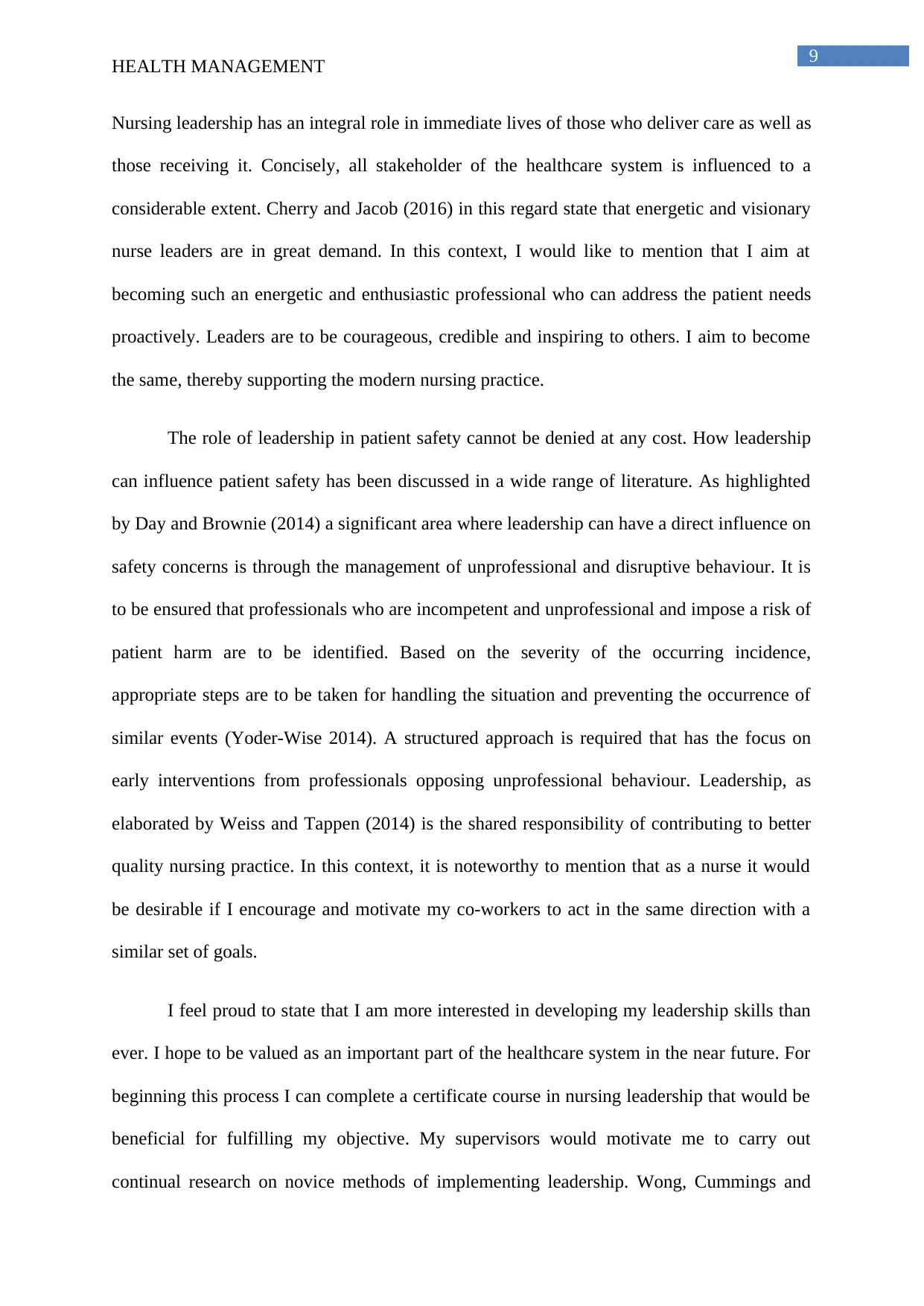
9
HEALTH MANAGEMENT
Nursing leadership has an integral role in immediate lives of those who deliver care as well as
those receiving it. Concisely, all stakeholder of the healthcare system is influenced to a
considerable extent. Cherry and Jacob (2016) in this regard state that energetic and visionary
nurse leaders are in great demand. In this context, I would like to mention that I aim at
becoming such an energetic and enthusiastic professional who can address the patient needs
proactively. Leaders are to be courageous, credible and inspiring to others. I aim to become
the same, thereby supporting the modern nursing practice.
The role of leadership in patient safety cannot be denied at any cost. How leadership
can influence patient safety has been discussed in a wide range of literature. As highlighted
by Day and Brownie (2014) a significant area where leadership can have a direct influence on
safety concerns is through the management of unprofessional and disruptive behaviour. It is
to be ensured that professionals who are incompetent and unprofessional and impose a risk of
patient harm are to be identified. Based on the severity of the occurring incidence,
appropriate steps are to be taken for handling the situation and preventing the occurrence of
similar events (Yoder-Wise 2014). A structured approach is required that has the focus on
early interventions from professionals opposing unprofessional behaviour. Leadership, as
elaborated by Weiss and Tappen (2014) is the shared responsibility of contributing to better
quality nursing practice. In this context, it is noteworthy to mention that as a nurse it would
be desirable if I encourage and motivate my co-workers to act in the same direction with a
similar set of goals.
I feel proud to state that I am more interested in developing my leadership skills than
ever. I hope to be valued as an important part of the healthcare system in the near future. For
beginning this process I can complete a certificate course in nursing leadership that would be
beneficial for fulfilling my objective. My supervisors would motivate me to carry out
continual research on novice methods of implementing leadership. Wong, Cummings and
HEALTH MANAGEMENT
Nursing leadership has an integral role in immediate lives of those who deliver care as well as
those receiving it. Concisely, all stakeholder of the healthcare system is influenced to a
considerable extent. Cherry and Jacob (2016) in this regard state that energetic and visionary
nurse leaders are in great demand. In this context, I would like to mention that I aim at
becoming such an energetic and enthusiastic professional who can address the patient needs
proactively. Leaders are to be courageous, credible and inspiring to others. I aim to become
the same, thereby supporting the modern nursing practice.
The role of leadership in patient safety cannot be denied at any cost. How leadership
can influence patient safety has been discussed in a wide range of literature. As highlighted
by Day and Brownie (2014) a significant area where leadership can have a direct influence on
safety concerns is through the management of unprofessional and disruptive behaviour. It is
to be ensured that professionals who are incompetent and unprofessional and impose a risk of
patient harm are to be identified. Based on the severity of the occurring incidence,
appropriate steps are to be taken for handling the situation and preventing the occurrence of
similar events (Yoder-Wise 2014). A structured approach is required that has the focus on
early interventions from professionals opposing unprofessional behaviour. Leadership, as
elaborated by Weiss and Tappen (2014) is the shared responsibility of contributing to better
quality nursing practice. In this context, it is noteworthy to mention that as a nurse it would
be desirable if I encourage and motivate my co-workers to act in the same direction with a
similar set of goals.
I feel proud to state that I am more interested in developing my leadership skills than
ever. I hope to be valued as an important part of the healthcare system in the near future. For
beginning this process I can complete a certificate course in nursing leadership that would be
beneficial for fulfilling my objective. My supervisors would motivate me to carry out
continual research on novice methods of implementing leadership. Wong, Cummings and
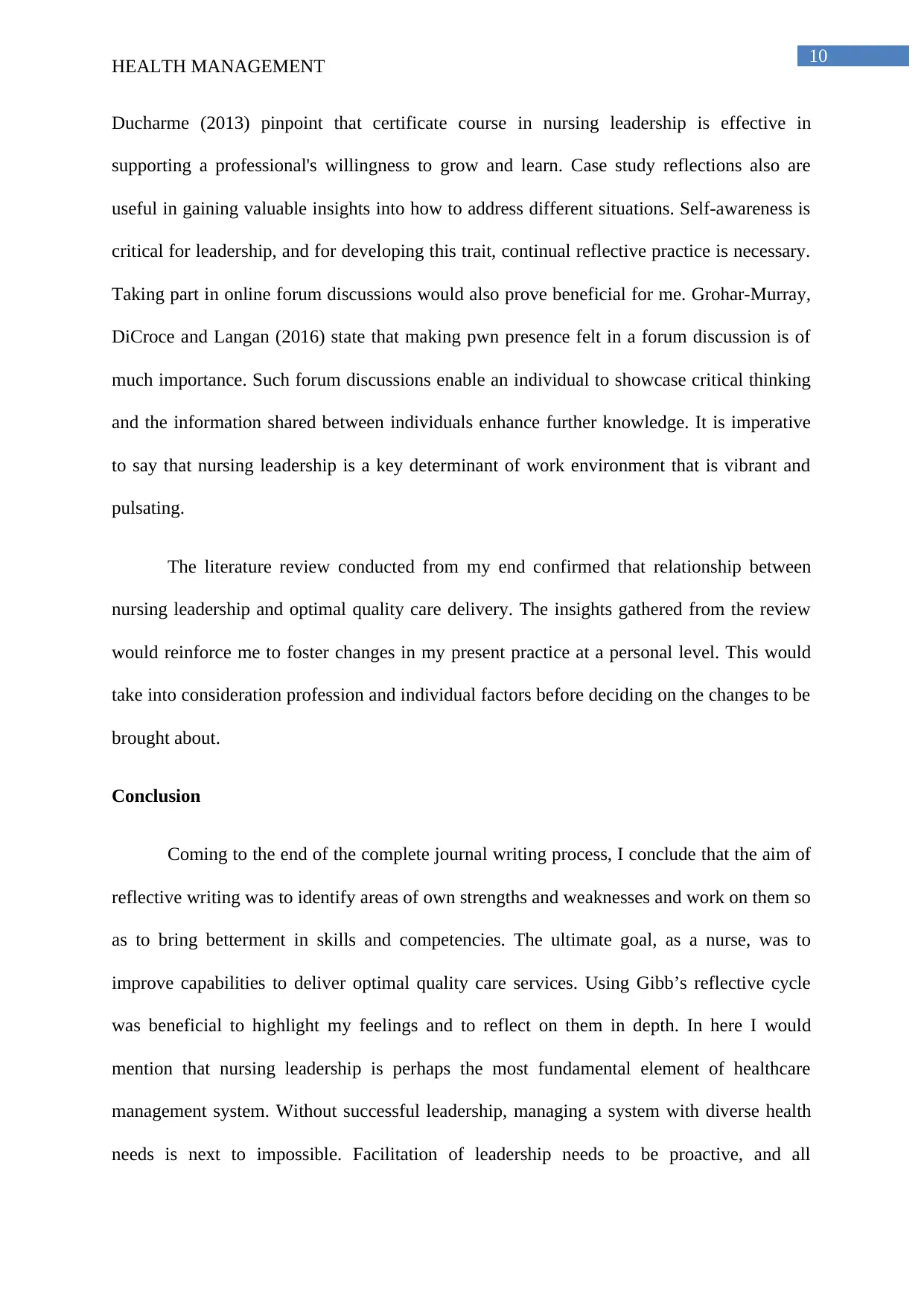
10
HEALTH MANAGEMENT
Ducharme (2013) pinpoint that certificate course in nursing leadership is effective in
supporting a professional's willingness to grow and learn. Case study reflections also are
useful in gaining valuable insights into how to address different situations. Self-awareness is
critical for leadership, and for developing this trait, continual reflective practice is necessary.
Taking part in online forum discussions would also prove beneficial for me. Grohar-Murray,
DiCroce and Langan (2016) state that making pwn presence felt in a forum discussion is of
much importance. Such forum discussions enable an individual to showcase critical thinking
and the information shared between individuals enhance further knowledge. It is imperative
to say that nursing leadership is a key determinant of work environment that is vibrant and
pulsating.
The literature review conducted from my end confirmed that relationship between
nursing leadership and optimal quality care delivery. The insights gathered from the review
would reinforce me to foster changes in my present practice at a personal level. This would
take into consideration profession and individual factors before deciding on the changes to be
brought about.
Conclusion
Coming to the end of the complete journal writing process, I conclude that the aim of
reflective writing was to identify areas of own strengths and weaknesses and work on them so
as to bring betterment in skills and competencies. The ultimate goal, as a nurse, was to
improve capabilities to deliver optimal quality care services. Using Gibb’s reflective cycle
was beneficial to highlight my feelings and to reflect on them in depth. In here I would
mention that nursing leadership is perhaps the most fundamental element of healthcare
management system. Without successful leadership, managing a system with diverse health
needs is next to impossible. Facilitation of leadership needs to be proactive, and all
HEALTH MANAGEMENT
Ducharme (2013) pinpoint that certificate course in nursing leadership is effective in
supporting a professional's willingness to grow and learn. Case study reflections also are
useful in gaining valuable insights into how to address different situations. Self-awareness is
critical for leadership, and for developing this trait, continual reflective practice is necessary.
Taking part in online forum discussions would also prove beneficial for me. Grohar-Murray,
DiCroce and Langan (2016) state that making pwn presence felt in a forum discussion is of
much importance. Such forum discussions enable an individual to showcase critical thinking
and the information shared between individuals enhance further knowledge. It is imperative
to say that nursing leadership is a key determinant of work environment that is vibrant and
pulsating.
The literature review conducted from my end confirmed that relationship between
nursing leadership and optimal quality care delivery. The insights gathered from the review
would reinforce me to foster changes in my present practice at a personal level. This would
take into consideration profession and individual factors before deciding on the changes to be
brought about.
Conclusion
Coming to the end of the complete journal writing process, I conclude that the aim of
reflective writing was to identify areas of own strengths and weaknesses and work on them so
as to bring betterment in skills and competencies. The ultimate goal, as a nurse, was to
improve capabilities to deliver optimal quality care services. Using Gibb’s reflective cycle
was beneficial to highlight my feelings and to reflect on them in depth. In here I would
mention that nursing leadership is perhaps the most fundamental element of healthcare
management system. Without successful leadership, managing a system with diverse health
needs is next to impossible. Facilitation of leadership needs to be proactive, and all
Secure Best Marks with AI Grader
Need help grading? Try our AI Grader for instant feedback on your assignments.
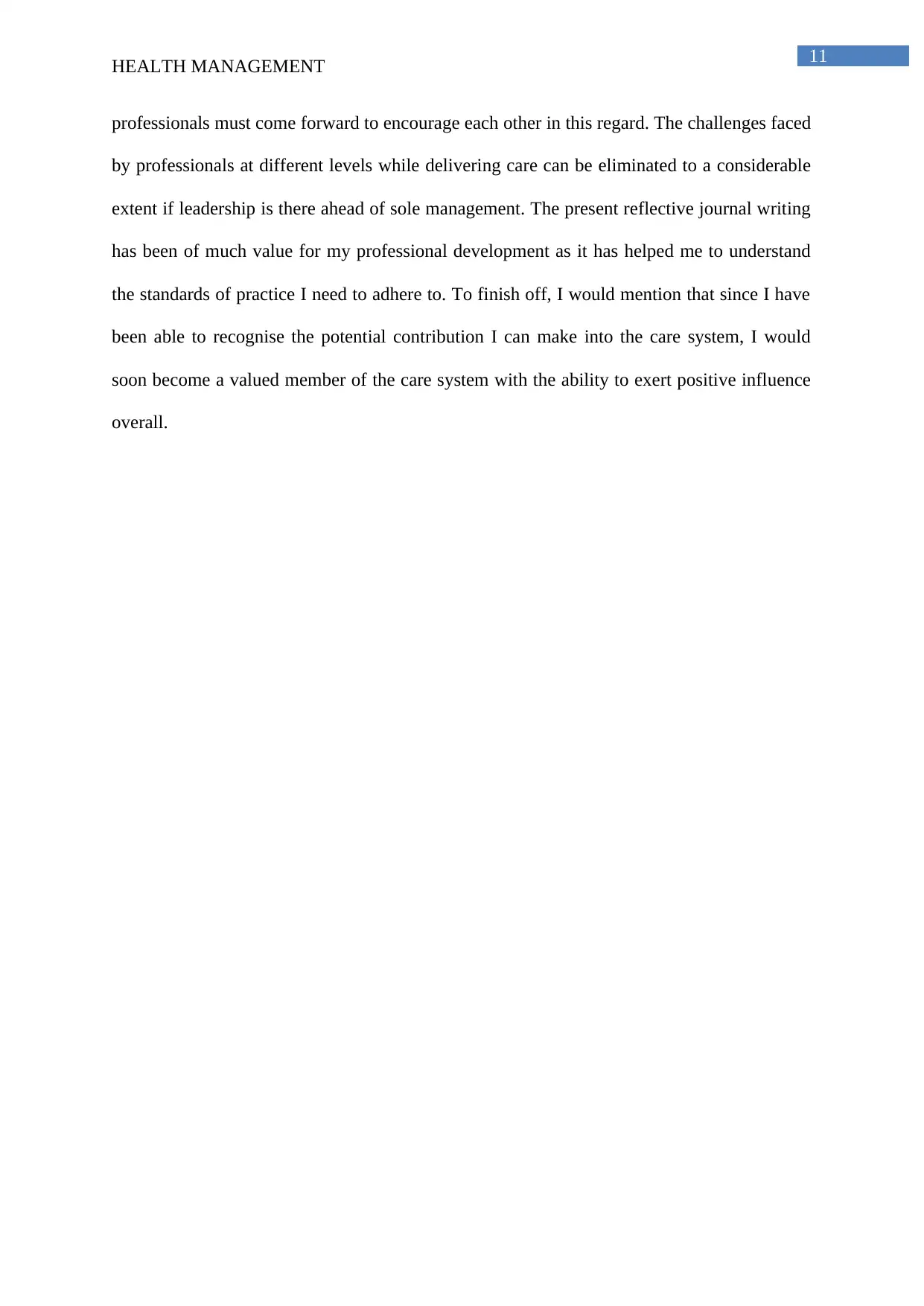
11
HEALTH MANAGEMENT
professionals must come forward to encourage each other in this regard. The challenges faced
by professionals at different levels while delivering care can be eliminated to a considerable
extent if leadership is there ahead of sole management. The present reflective journal writing
has been of much value for my professional development as it has helped me to understand
the standards of practice I need to adhere to. To finish off, I would mention that since I have
been able to recognise the potential contribution I can make into the care system, I would
soon become a valued member of the care system with the ability to exert positive influence
overall.
HEALTH MANAGEMENT
professionals must come forward to encourage each other in this regard. The challenges faced
by professionals at different levels while delivering care can be eliminated to a considerable
extent if leadership is there ahead of sole management. The present reflective journal writing
has been of much value for my professional development as it has helped me to understand
the standards of practice I need to adhere to. To finish off, I would mention that since I have
been able to recognise the potential contribution I can make into the care system, I would
soon become a valued member of the care system with the ability to exert positive influence
overall.
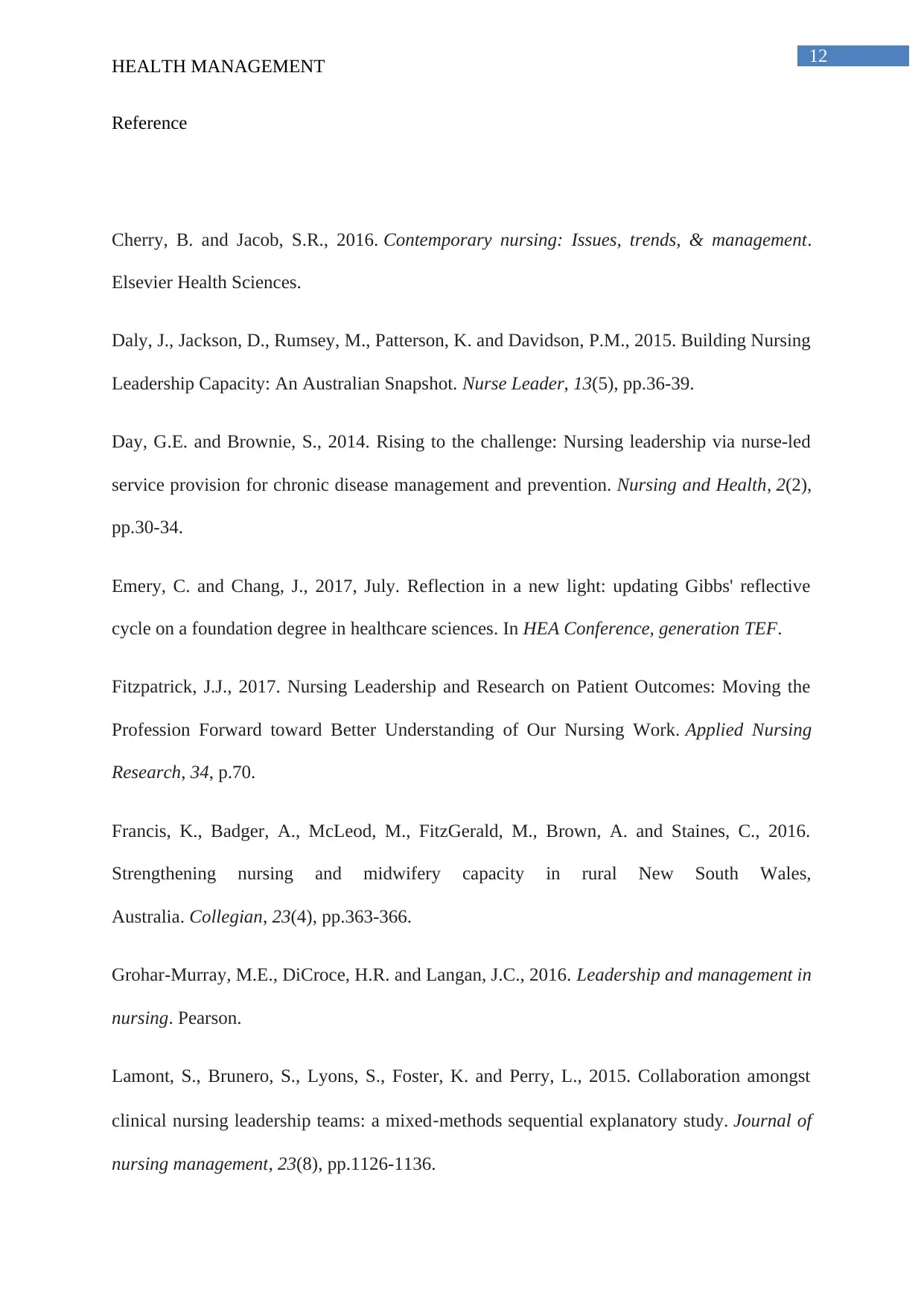
12
HEALTH MANAGEMENT
Reference
Cherry, B. and Jacob, S.R., 2016. Contemporary nursing: Issues, trends, & management.
Elsevier Health Sciences.
Daly, J., Jackson, D., Rumsey, M., Patterson, K. and Davidson, P.M., 2015. Building Nursing
Leadership Capacity: An Australian Snapshot. Nurse Leader, 13(5), pp.36-39.
Day, G.E. and Brownie, S., 2014. Rising to the challenge: Nursing leadership via nurse-led
service provision for chronic disease management and prevention. Nursing and Health, 2(2),
pp.30-34.
Emery, C. and Chang, J., 2017, July. Reflection in a new light: updating Gibbs' reflective
cycle on a foundation degree in healthcare sciences. In HEA Conference, generation TEF.
Fitzpatrick, J.J., 2017. Nursing Leadership and Research on Patient Outcomes: Moving the
Profession Forward toward Better Understanding of Our Nursing Work. Applied Nursing
Research, 34, p.70.
Francis, K., Badger, A., McLeod, M., FitzGerald, M., Brown, A. and Staines, C., 2016.
Strengthening nursing and midwifery capacity in rural New South Wales,
Australia. Collegian, 23(4), pp.363-366.
Grohar-Murray, M.E., DiCroce, H.R. and Langan, J.C., 2016. Leadership and management in
nursing. Pearson.
Lamont, S., Brunero, S., Lyons, S., Foster, K. and Perry, L., 2015. Collaboration amongst
clinical nursing leadership teams: a mixed‐methods sequential explanatory study. Journal of
nursing management, 23(8), pp.1126-1136.
HEALTH MANAGEMENT
Reference
Cherry, B. and Jacob, S.R., 2016. Contemporary nursing: Issues, trends, & management.
Elsevier Health Sciences.
Daly, J., Jackson, D., Rumsey, M., Patterson, K. and Davidson, P.M., 2015. Building Nursing
Leadership Capacity: An Australian Snapshot. Nurse Leader, 13(5), pp.36-39.
Day, G.E. and Brownie, S., 2014. Rising to the challenge: Nursing leadership via nurse-led
service provision for chronic disease management and prevention. Nursing and Health, 2(2),
pp.30-34.
Emery, C. and Chang, J., 2017, July. Reflection in a new light: updating Gibbs' reflective
cycle on a foundation degree in healthcare sciences. In HEA Conference, generation TEF.
Fitzpatrick, J.J., 2017. Nursing Leadership and Research on Patient Outcomes: Moving the
Profession Forward toward Better Understanding of Our Nursing Work. Applied Nursing
Research, 34, p.70.
Francis, K., Badger, A., McLeod, M., FitzGerald, M., Brown, A. and Staines, C., 2016.
Strengthening nursing and midwifery capacity in rural New South Wales,
Australia. Collegian, 23(4), pp.363-366.
Grohar-Murray, M.E., DiCroce, H.R. and Langan, J.C., 2016. Leadership and management in
nursing. Pearson.
Lamont, S., Brunero, S., Lyons, S., Foster, K. and Perry, L., 2015. Collaboration amongst
clinical nursing leadership teams: a mixed‐methods sequential explanatory study. Journal of
nursing management, 23(8), pp.1126-1136.
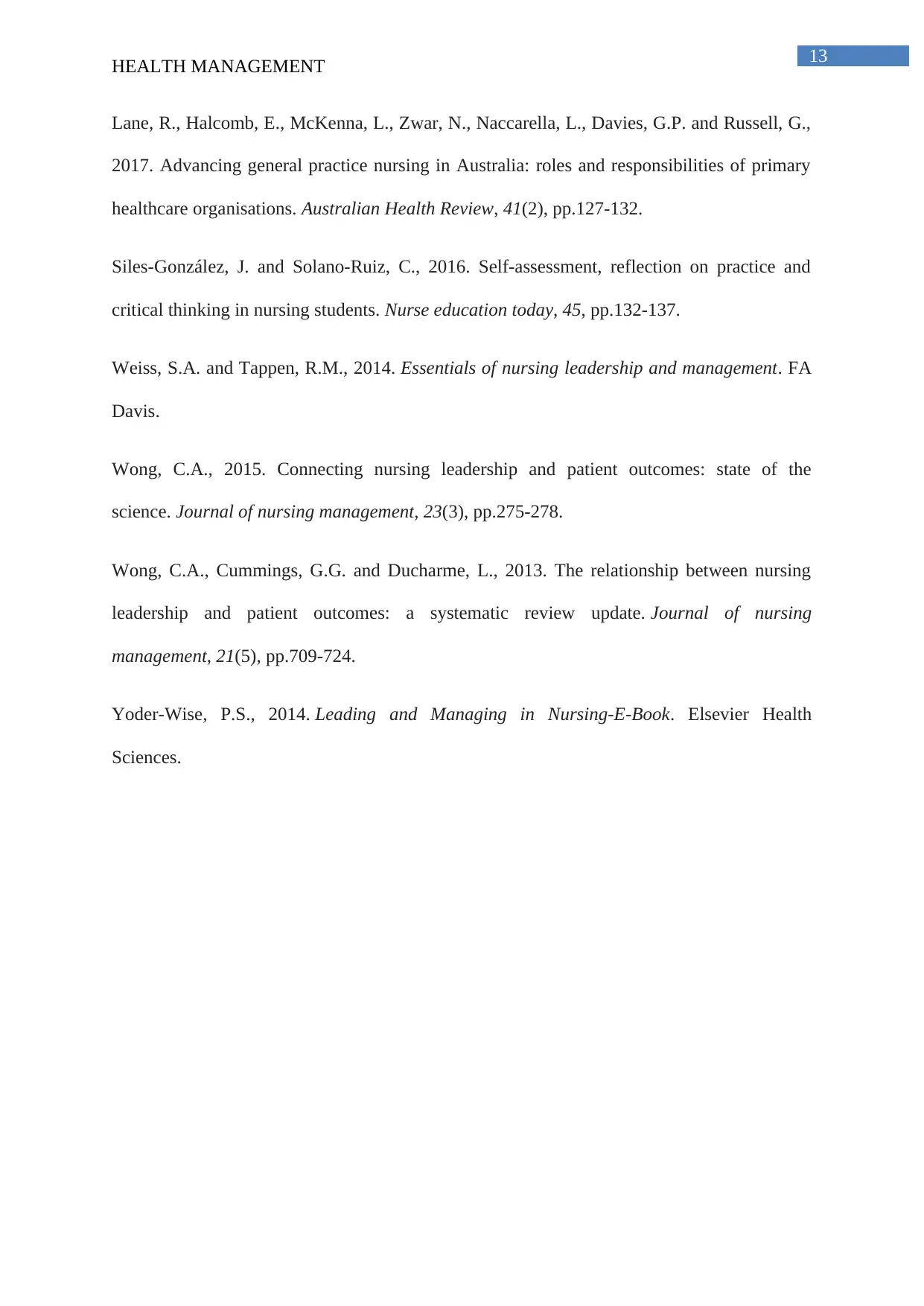
13
HEALTH MANAGEMENT
Lane, R., Halcomb, E., McKenna, L., Zwar, N., Naccarella, L., Davies, G.P. and Russell, G.,
2017. Advancing general practice nursing in Australia: roles and responsibilities of primary
healthcare organisations. Australian Health Review, 41(2), pp.127-132.
Siles-González, J. and Solano-Ruiz, C., 2016. Self-assessment, reflection on practice and
critical thinking in nursing students. Nurse education today, 45, pp.132-137.
Weiss, S.A. and Tappen, R.M., 2014. Essentials of nursing leadership and management. FA
Davis.
Wong, C.A., 2015. Connecting nursing leadership and patient outcomes: state of the
science. Journal of nursing management, 23(3), pp.275-278.
Wong, C.A., Cummings, G.G. and Ducharme, L., 2013. The relationship between nursing
leadership and patient outcomes: a systematic review update. Journal of nursing
management, 21(5), pp.709-724.
Yoder-Wise, P.S., 2014. Leading and Managing in Nursing-E-Book. Elsevier Health
Sciences.
HEALTH MANAGEMENT
Lane, R., Halcomb, E., McKenna, L., Zwar, N., Naccarella, L., Davies, G.P. and Russell, G.,
2017. Advancing general practice nursing in Australia: roles and responsibilities of primary
healthcare organisations. Australian Health Review, 41(2), pp.127-132.
Siles-González, J. and Solano-Ruiz, C., 2016. Self-assessment, reflection on practice and
critical thinking in nursing students. Nurse education today, 45, pp.132-137.
Weiss, S.A. and Tappen, R.M., 2014. Essentials of nursing leadership and management. FA
Davis.
Wong, C.A., 2015. Connecting nursing leadership and patient outcomes: state of the
science. Journal of nursing management, 23(3), pp.275-278.
Wong, C.A., Cummings, G.G. and Ducharme, L., 2013. The relationship between nursing
leadership and patient outcomes: a systematic review update. Journal of nursing
management, 21(5), pp.709-724.
Yoder-Wise, P.S., 2014. Leading and Managing in Nursing-E-Book. Elsevier Health
Sciences.
1 out of 13
Related Documents
Your All-in-One AI-Powered Toolkit for Academic Success.
+13062052269
info@desklib.com
Available 24*7 on WhatsApp / Email
![[object Object]](/_next/static/media/star-bottom.7253800d.svg)
Unlock your academic potential
© 2024 | Zucol Services PVT LTD | All rights reserved.





